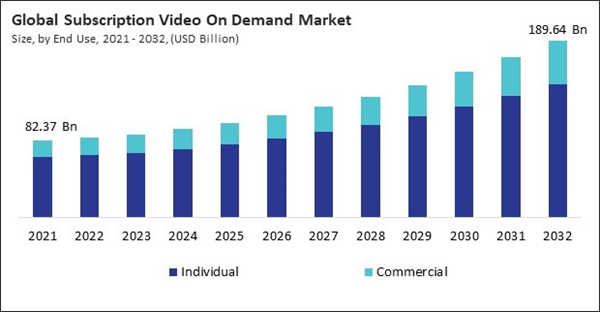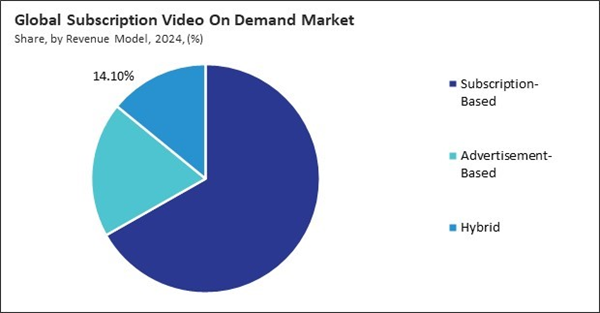Personalized recommendations, user-friendly interfaces, and device flexibility (access across mobile, laptop, tablet, and smart TV) further reinforce the appeal of individual subscriptions. This segment is expected to continue leading the market due to the continued shift toward digital-first, self-curated viewing experiences.
Driving and Restraining Factors
Drivers
- Digital Infrastructure And Internet Penetration
- Content Diversification And Original Programming
- Changing Consumer Behavior And Cord-Cutting Trends
- Global Expansion And Localization Strategies
Restraints
- Market Saturation And Subscription Fatigue
- Rising Content Costs And Monetization Pressure
- Piracy And Unregulated Content Distribution
Opportunities
- Expansion Of Niche Content Ecosystems And Fan Communities
- Integration Of Interactive And Immersive Technologies
- Strategic Collaborations With Non-Media Sectors
Challenges
- Managing User Data, Privacy, And Personalization Ethics
- Platform Fragmentation And Cross-Device Experience
- Retention In An Era Of Instant Gratification
Market Growth Factors
The transformation of digital infrastructure globally has laid a strong foundation for the Subscription Video On Demand (SVOD) market. With broadband networks expanding and mobile internet becoming more affordable, the accessibility of high-speed internet has surged dramatically. Particularly in emerging economies, the widespread rollout of 4G - and increasingly 5G - has brought seamless streaming experiences to vast new user bases. This shift has empowered mobile-first consumption, especially in regions where traditional cable and satellite infrastructure is limited or non-existent. Consumers in countries such as India, Nigeria, and Indonesia are increasingly watching premium video content on smartphones, thanks to cost-effective data packages and improved network reliability. In conclusion, robust digital infrastructure and internet penetration are the critical enablers of the global SVOD revolution, turning streaming from a luxury into a mainstream lifestyle.Additionally, A key competitive lever in the SVOD market is content, and platforms have moved aggressively to produce and curate a rich variety of shows and films. The transition from being content aggregators to original content creators has empowered services like Netflix, Amazon Prime Video, and Disney+ to differentiate themselves in a crowded marketplace. Exclusive content becomes a primary driver for subscriptions, especially when it reaches iconic or viral status. In conclusion, compelling original content and diversified programming lie at the heart of SVOD’s success, ensuring sustained viewer loyalty and differentiation.
Market Restraining Factors
As the SVOD market matures, one of the most significant challenges it faces is market saturation and subscription fatigue. Initially, the novelty of streaming platforms like Netflix and Amazon Prime Video offered consumers an attractive alternative to traditional pay-TV services. However, the subsequent influx of numerous new entrants - such as Disney+, HBO Max, Apple TV+, Paramount+, and regional players - has crowded the landscape. This proliferation has led to an overwhelming number of choices for consumers, many of whom now subscribe to multiple platforms just to access their favorite shows. Hence, market saturation and subscription fatigue are curbing the momentum of the SVOD market, challenging providers to rethink value delivery, user retention, and long-term scalability.Value Chain Analysis
The Subscription Video On Demand (SVOD) market value chain begins with content creation and acquisition, forming the core offering for platforms. This is followed by content aggregation and management, ensuring organized, accessible media libraries. Platform development and technology infrastructure support delivery through scalable, user-friendly systems. The content delivery (distribution) stage ensures seamless streaming experiences, complemented by marketing and customer acquisition to expand the user base. Subscription management and monetization handle payments and access, while customer support and retention maintain satisfaction and loyalty, ultimately cycling back into improving content and services.
Market Share Analysis
The leading players in the market are competing with diverse innovative offerings to remain competitive in the market. The above illustration shows the percentage of revenue shared by some of the leading companies in the market. The leading players of the market are adopting various strategies in order to cater demand coming from the different industries. The key developmental strategies in the market are Acquisitions, and Partnerships & Collaborations.
COVID-19 Impact Analysis
During the COVID-19 lockdowns, consumers spent significantly more time at home, which led to a sharp increase in demand for Subscription Video On Demand (SVOD) services. Platforms such as Netflix, Amazon Prime Video, and Disney+ saw substantial growth in both viewership and subscriber numbers. For instance, Netflix added over 36 million subscribers in 2020, while Disney+ surpassed 100 million subscribers by early 2021 - figures that exceeded expectations. These platforms became essential sources of entertainment while traditional venues like cinemas and theaters remained closed. The pandemic also accelerated a shift in consumer behavior. Viewers increasingly moved away from traditional cable TV and adopted digital streaming options. Families relied on streaming services not just for movies and series, but also for children's programming and educational content, which became particularly valuable during school closures. Thus, the COVID-19 pandemic had positive impact on the market.End Use Outlook
Based on end use, the subscription video on demand market is segmented into individual and commercial. The commercial segment acquired 22% revenue share in the subscription video on demand market in 2024. Commercial applications span across hospitality (hotels offering in-room streaming), educational institutions (using documentaries and educational series), fitness centers (providing content for clients), and even corporate training environments. Businesses are increasingly integrating SVOD platforms to enhance customer experiences or support employee engagement and learning.Revenue Model Outlook
By revenue model, the subscription video on demand market is divided into subscription-based, advertisement-based, and hybrid. The advertisement-based segment garnered 19% revenue share in the subscription video on demand market in 2024. It is showing notable growth driven by price-sensitive viewers and increased platform monetization strategies. This model enables users to access content for free or at a lower subscription cost in exchange for viewing periodic advertisements. It has gained momentum among streaming platforms seeking to expand reach in emerging markets or among cost-conscious consumers.Content Type Outlook
On the basis of content type, the subscription video on demand market is classified into movies, TV shows, documentaries, and others. The TV shows segment recorded 34% revenue share in the subscription video on demand market in 2024. This is driven by the growing appetite for episodic and binge-worthy content. With the rise of limited series, dramas, reality shows, and sitcoms tailored to diverse viewer preferences, TV shows have become a central offering on streaming platforms. Services such as Netflix, Hulu, and Amazon Prime Video have emphasized long-form storytelling, character development, and high production quality, attracting sustained viewership.Device Type Outlook
Based on device type, the subscription video on demand market is characterized into laptops, smartphones, smart TVs, tablets, and others. The smartphones segment procured 31% revenue share in the subscription video on demand market in 2024. This is reflecting their critical role in driving mobile-first streaming behavior. With widespread internet access, 5G rollout, and the proliferation of budget-friendly smartphones with HD displays, users now have easier and faster access to on-demand video content. Streaming services have optimized their platforms for mobile use, offering data-saving modes, offline downloads, and exclusive mobile subscriptions.Regional Outlook
Region-wise, the subscription video on demand market is analyzed across North America, Europe, Asia Pacific, and LAMEA. The North America segment recorded 43% revenue share in the subscription video on demand market in 2024. This dominance is supported by high internet penetration, widespread adoption of smart devices, and a mature streaming ecosystem. The presence of major global players such as Netflix, Hulu, Amazon Prime Video, and Disney+ - all headquartered in this region - further contributes to its leadership. Consumers in North America exhibit a strong appetite for premium content, original productions, and multi-device accessibility.Recent Strategies Deployed in the Market
- May-2025: Netflix, Inc. announced the partnership with OzTAM, a market research company to join its VOZ Total TV measurement system, marking the first time a global streamer will have independently reported audience data in Australia. This move enhances transparency for advertisers and signals a shift toward unified TV and streaming audience measurement across all platforms.
- Mar-2025: DAZN Limited acquired Foxtel, a broadband company, expanding its presence in Australia’s sports streaming market. Foxtel, including Kayo Sports and BINGE, will operate independently within DAZN. The deal leverages DAZN’s global scale and tech to grow Foxtel’s subscriber base and deliver more sports content worldwide.
- Dec-2024: Warner Bros. Discovery, Inc. announced the partnership with Comcast, provides a wide range of services, including cable TV, internet, phone, and wireless to renew distribution of WBD’s linear networks and HBO for Xfinity, while expanding streaming rights for Max and Discovery+. In the UK and Ireland, Sky and WBD will bundle the ad-supported Max app with Sky services, launching in early 2026.
- Jul-2024: Warner Bros. Discovery, Inc. teamed up with Hepsiburada, an E-commerce company to offer BluTV subscriptions as a benefit for its Premium members. This collaboration enhances BluTV's reach in Türkiye, providing access to Turkish and international content. The move supports growth for both brands and enriches Hepsiburada’s value proposition for its 2.6 million subscribers.
- Apr-2024: Paramount Plus teamed up with the National Park Foundation, offering live streams and on-demand content of U.S. national parks. This collaboration promotes park preservation and provides viewers immersive access to iconic parks through solar-powered live streams and exclusive footage.
List of Key Companies Profiled
- Netflix, Inc.
- The Walt Disney Company (Disney+)
- Google LLC (Youtube, LLC)
- Amazon.com, Inc. (Amazon Prime Video)
- Apple, Inc. (Apple TV+)
- Warner Bros. Discovery, Inc. (HBO Max)
- Paramount Plus
- Peacock TV, LLC (NBCUniversal Media, LLC)
- iQIYI, Inc.
- DAZN Limited
Market Report Segmentation
By End Use
- Individual
- Commercial
By Revenue Model
- Subscription-Based
- Advertisement-Based
- Hybrid
By Content Type
- Movies
- TV Shows
- Documentaries
- Other Content Type
By Device Type
- Laptops
- Smartphones
- Smart TVs
- Tablets
- Other Device Type
By Geography
- North America
- US
- Canada
- Mexico
- Rest of North America
- Europe
- Germany
- UK
- France
- Russia
- Spain
- Italy
- Rest of Europe
- Asia Pacific
- China
- Japan
- India
- South Korea
- Singapore
- Malaysia
- Rest of Asia Pacific
- LAMEA
- Brazil
- Argentina
- UAE
- Saudi Arabia
- South Africa
- Nigeria
- Rest of LAMEA
Table of Contents
Companies Mentioned
- Netflix, Inc.
- The Walt Disney Company (Disney+)
- Google LLC (Youtube, LLC)
- Amazon.com, Inc. (Amazon Prime Video)
- Apple, Inc. (Apple TV+)
- Warner Bros. Discovery, Inc. (HBO Max)
- Paramount Plus
- Peacock TV, LLC (NBCUniversal Media, LLC)
- iQIYI, Inc.
- DAZN Limited












